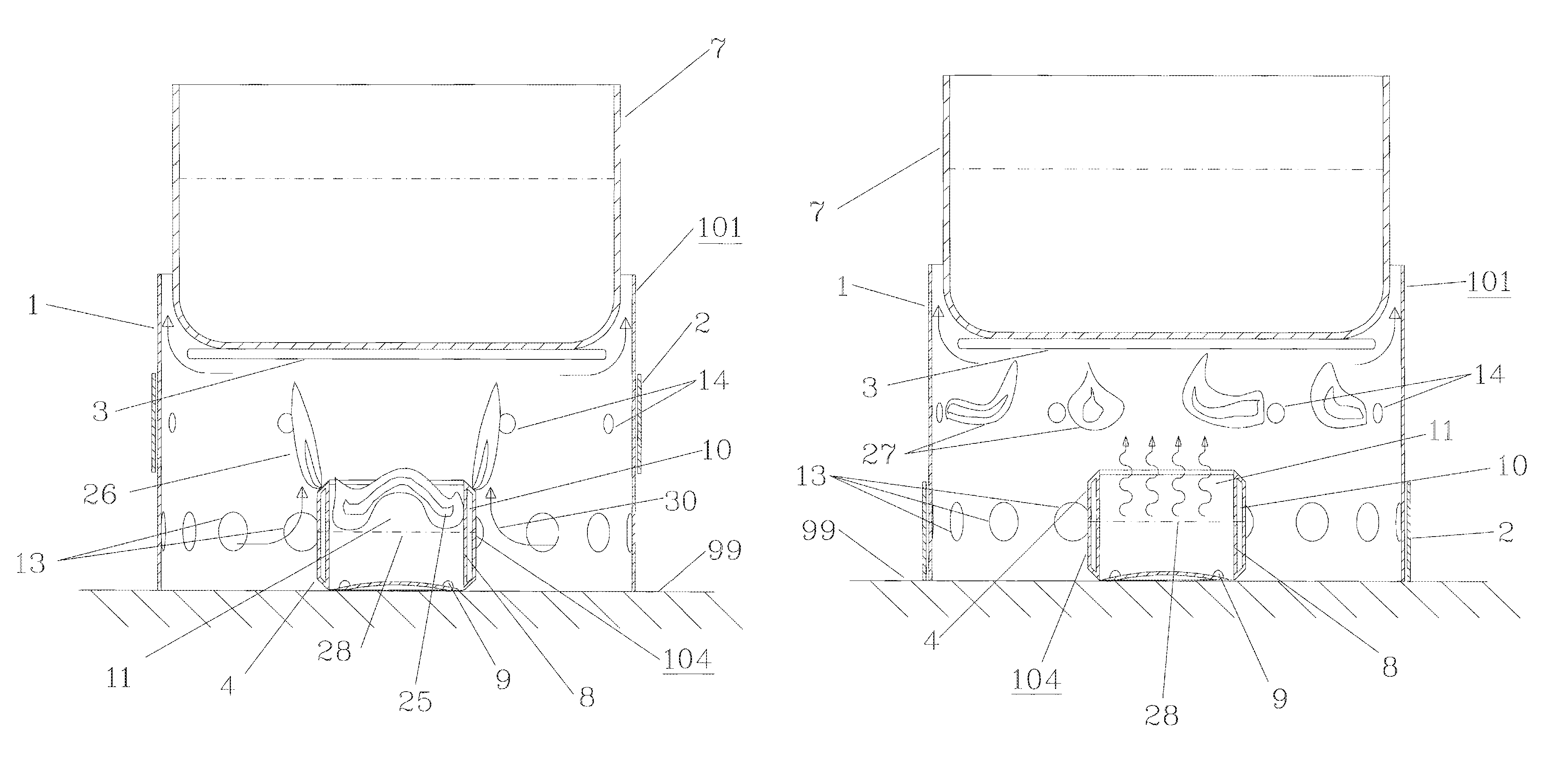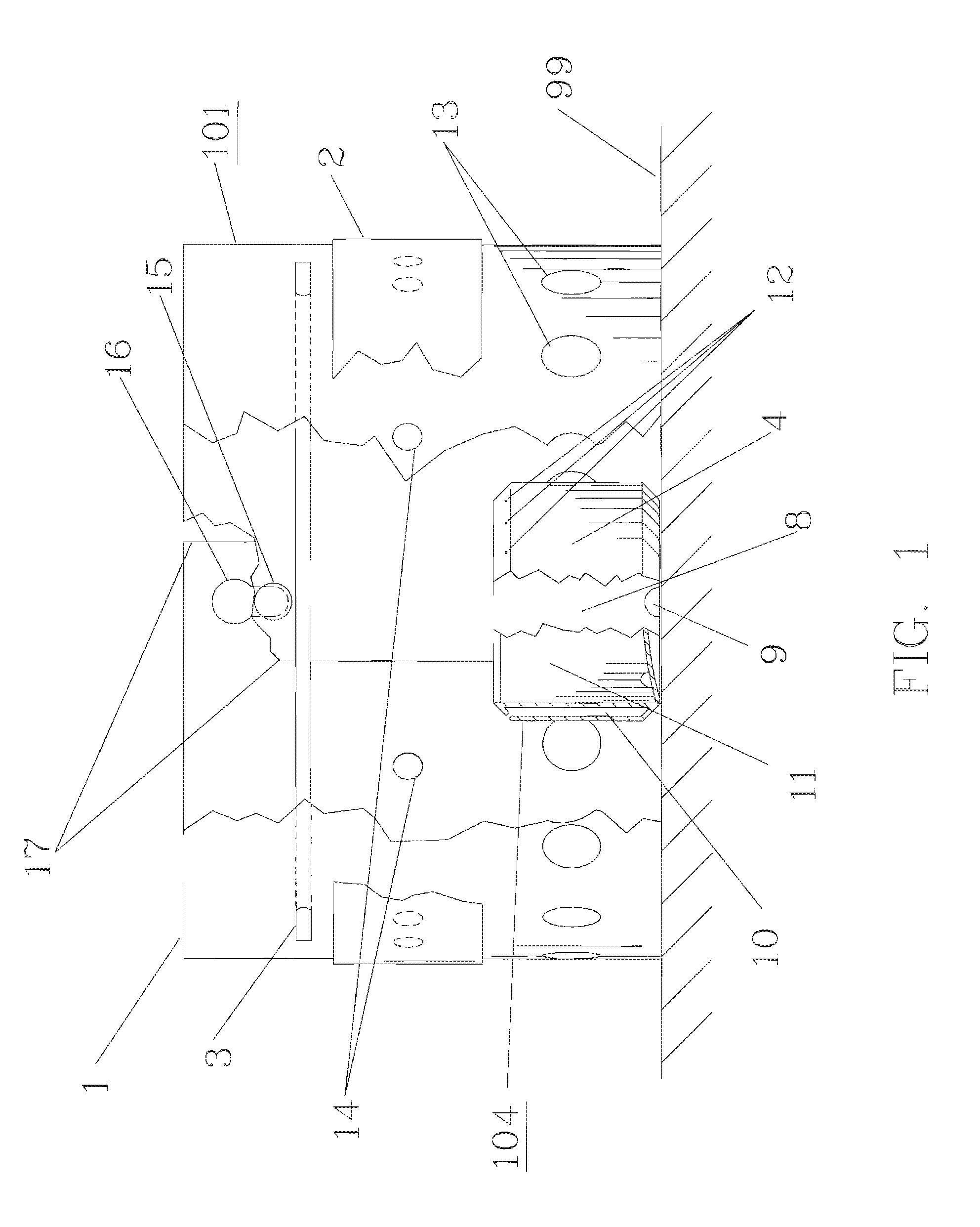Lightweight, portable cooking stove
a portable, small technology, applied in the direction of domestic stoves or ranges, gaseous heating fuel, combustion types, etc., can solve the problems of limited popularity of alcohol-fueled stoves in the united states, poor overall performance, etc., to prevent the uneven distribution of heat, convenient, safe and simple, and convenient to operate
- Summary
- Abstract
- Description
- Claims
- Application Information
AI Technical Summary
Benefits of technology
Problems solved by technology
Method used
Image
Examples
embodiment 104
[0089]FIG. 8 shows a plan view of an alternate embodiment of the fuel vaporizer 131. FIG. 9 shows a cutaway elevation view of this alternate embodiment fuel vaporizer 131, and FIG. 10 shows a perspective view. The alternate embodiment of the fuel vaporizer 131 is adapted to concentrate a large amount of heat on a small, confined chamber 34. The alternate embodiment fuel vaporizer 131 also surrounds and envelopes this small, confined chamber 34 in such a way that very little heat can escape from it. In this way the alternate embodiment of the fuel vaporizer 131 is capable of achieving a high rate of fuel vaporization with the concatenate effect of a high overall heat output for the stove. The alternate embodiment fuel vaporizer 131 is potentially capable of even greater heat output than the preferred embodiment 104 of the fuel vaporizer.
[0090]The alternate embodiment of the fuel vaporizer 131 comprises a vessel in the shape of a shallow, cylindrical cup 31. This shallow, cylindrical ...
embodiment 140
[0100]FIG. 15 shows a perspective view of an alternate embodiment of the fuel vaporizer 140. FIG. 16 shows a cutaway, sectional elevation view of this alternate embodiment 140. The alternate embodiment of the fuel vaporizer 140 is provided with cylindrical duct 53 coaxial with the body of the fuel vaporizer. This cylindrical duct 53 extends thru the center of the fuel vaporizer 140. This cylindrical duct 53 is adapted to provide a source of combustion air to the center of the fuel vaporizer 140. By providing combustion air to the center of the fuel vaporizer 140, complete combustion of the vaporized fuel can be effected.
[0101]The alternate embodiment 140 shares various features with the alternate embodiment 131 of the fuel vaporizer, and operates in a similar manner. The alternate embodiment of the fuel vaporizer 140 comprises a vessel in the shape of a shallow, cylindrical cup 49. This shallow, cylindrical cup 49 incorporates a double wall 50. By means of this double wall 50 the in...
embodiment 180
[0106]FIG. 29 shows a plan view of an alternate embodiment of the fuel vaporizer 180. FIG 30 shows a cutaway, sectional elevation view of this alternate embodiment 180. The alternate embodiment 180 shares various features with the alternate embodiments 140 and 145 of the fuel vaporizer, and operates in a similar manner. The alternate embodiment of the fuel vaporizer 180 is provided with cylindrical duct 97 coaxial with the body of the fuel vaporizer. This cylindrical duct 97 extends thru the center of the fuel vaporizer 180. This cylindrical duct 97 is adapted to provide a source of combustion air to the center of the fuel vaporizer 180. By providing combustion air to the center of the fuel vaporizer 180, complete combustion of the vaporized fuel can be effected.
[0107]The alternate embodiment of the fuel vaporizer 180 comprises a vessel in the shape of a shallow, cylindrical cup 91. This shallow, cylindrical cup 91 comprises a double wall 98. By means of this double wall 98 the inte...
PUM
 Login to View More
Login to View More Abstract
Description
Claims
Application Information
 Login to View More
Login to View More - R&D
- Intellectual Property
- Life Sciences
- Materials
- Tech Scout
- Unparalleled Data Quality
- Higher Quality Content
- 60% Fewer Hallucinations
Browse by: Latest US Patents, China's latest patents, Technical Efficacy Thesaurus, Application Domain, Technology Topic, Popular Technical Reports.
© 2025 PatSnap. All rights reserved.Legal|Privacy policy|Modern Slavery Act Transparency Statement|Sitemap|About US| Contact US: help@patsnap.com



